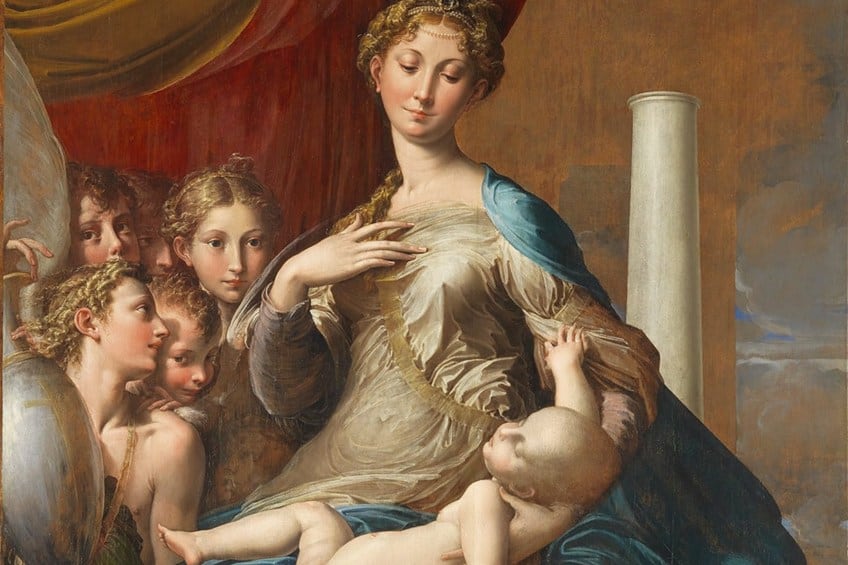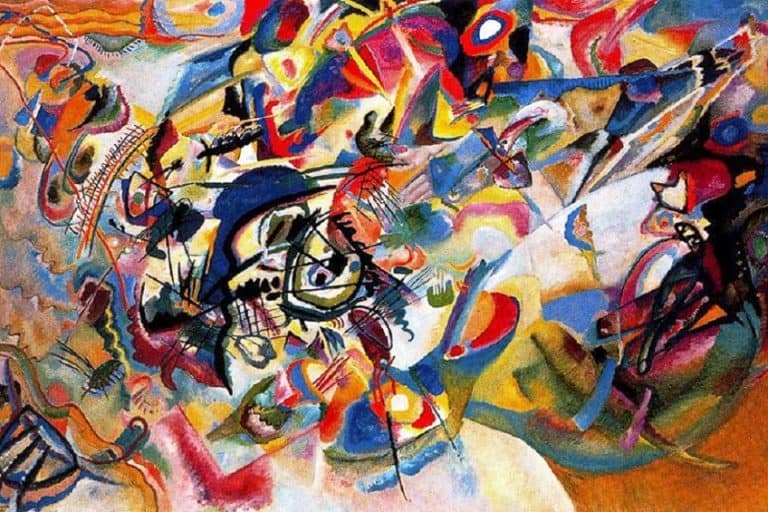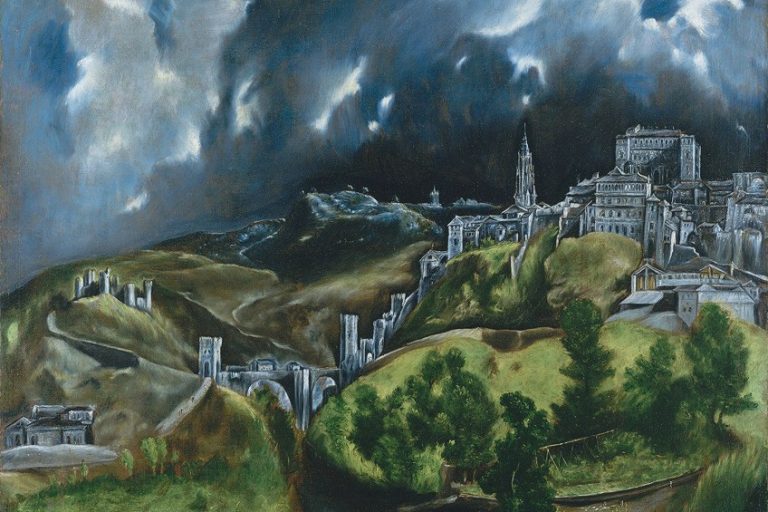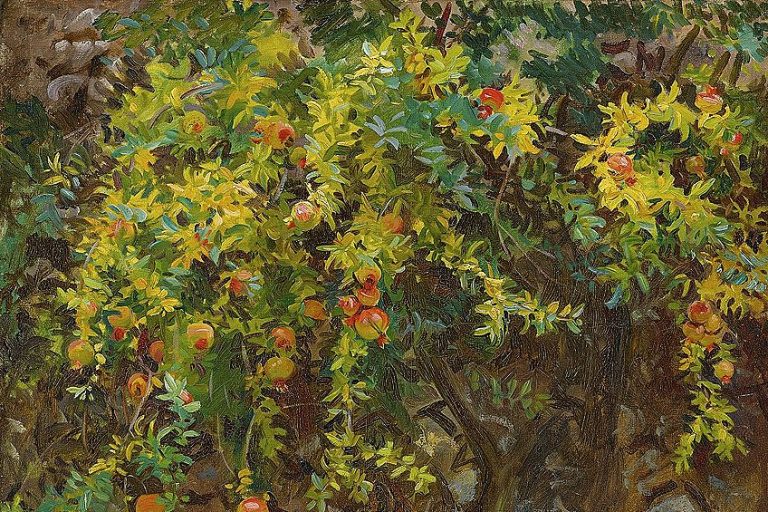“Madonna With the Long Neck” – Francesco Mazzola’s Masterpiece
Mannerist artists often depicted elongated figures in their paintings and reacted against the Classicism weaved within the fibers of the High Renaissance. This article will discuss the Mannerist Madonna With the Long Neck (1534-1540) painting by Francesco Mazzola.
Table of Contents
Artist Abstract: Who Was Francesco Mazzola, or Parmigianino?
The Mannerist painter Girolamo Francesco Maria Mazzola, who was also known as Parmigianino, was born on January 11, 1503, and died on August 24, 1540. He was born in Parma, Italy, and was a skilled painter in his teenage years, taught by his father and uncles.
His art career was short – he lived to be 37 years old – but he created various types of artworks including religious paintings and etchings.
He lived in numerous places, including Bologna and Rome and had several commissions. He also practiced alchemy. He was believed to be one of the forefathers of the Mannerist art style, and his artworks were characterized by his elongation of forms and the focus on ideals of beauty and sensuality. Some of his artworks include Self-portrait in a Convex Mirror (c. 1524), Vision of Saint Jerome (1526-1527), and The Mystic Marriage of Saint Catherine (c. 1531).
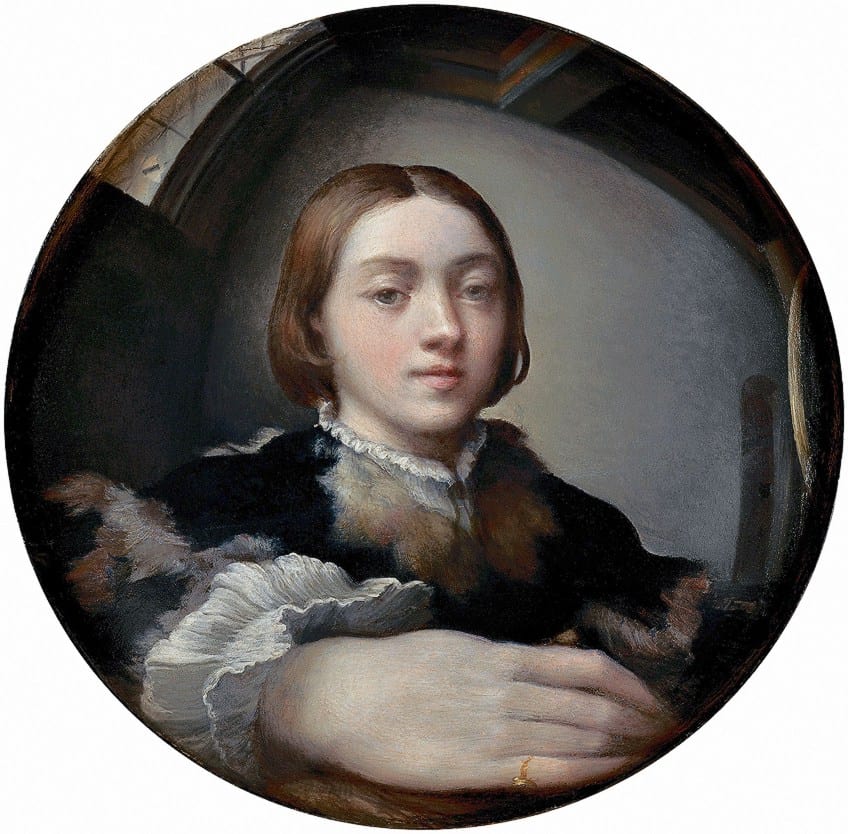
Madonna With the Long Neck (1534 – 1540) by Parmigianino in Context
Below, we will look at Madonna With the Long Neck (also titled Madonna and Child With Angels) by Francesco Mazzola, who we will refer to as Parmigianino in this article. We will discuss who commissioned it and what the Mannerist art style was in a brief contextual analysis, which will be followed by a discussion of the formal qualities of the painting.
| Artist | Francesco “Parmigianino” Mazzola |
| Date Painted | 1534 – 1540 |
| Medium | Oil on panel |
| Genre | Religious painting |
| Period / Movement | Mannerism |
| Dimensions (cm) | 216.5 x 132.5 |
| Series / Versions | N/A |
| Where Is It Housed? | Uffizi Gallery, Florence, Italy |
| What It Is Worth | Purchased in 1698 by Ferdinando de’ Medici; the exact price is uncertain. |
Contextual Analysis: A Brief Socio-Historical Overview
Madonna With the Long Neck by Parmigianino was started in 1534 as a commission from Elena Baiardi Tagliaferri for her husband’s, who was Francesco Tagliaferri, funerary chapel, which was in the Santa Maria dei Servi church located in Parma.
Parmigianino died in 1540, reportedly from a fever, thus leaving the painting unfinished.
In 1698, the painting was bought by the Grand Prince of Tuscany, Ferdinando de’ Medici, as part of his art collection. Reportedly, it has been exhibited since 1948 in the Uffizi Gallery.
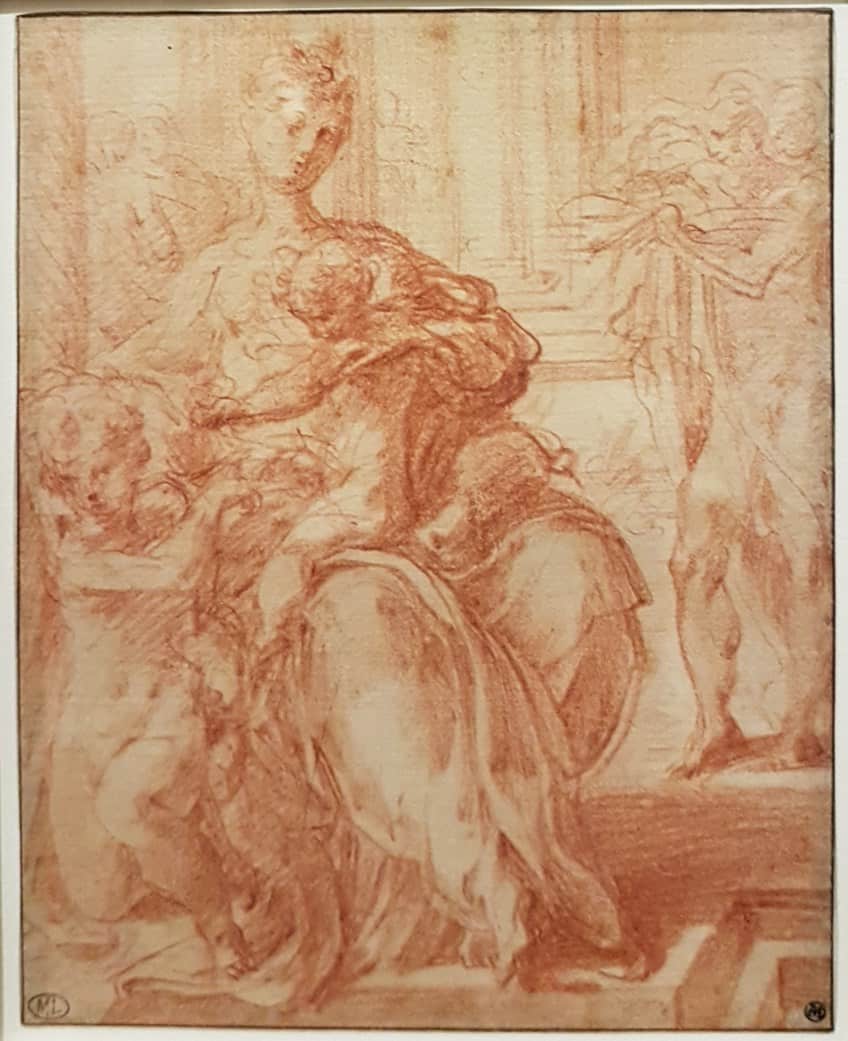
Deeper Meanings of Madonna With the Long Neck
Madonna With the Long Neck was reportedly based on medieval hymns that associated the Virgin Mary’s neck with columns, or a tower, which also points to a deeper religious meaning. The Madonna With the Long Neck painting has also been described as having sensual undertones, more specifically, the physical aspects of some of the figures.
For example, the Virgin Mary’s right hand is delicately placed near her chest and the semi-nude angel to the left has his bare leg open to the viewers.
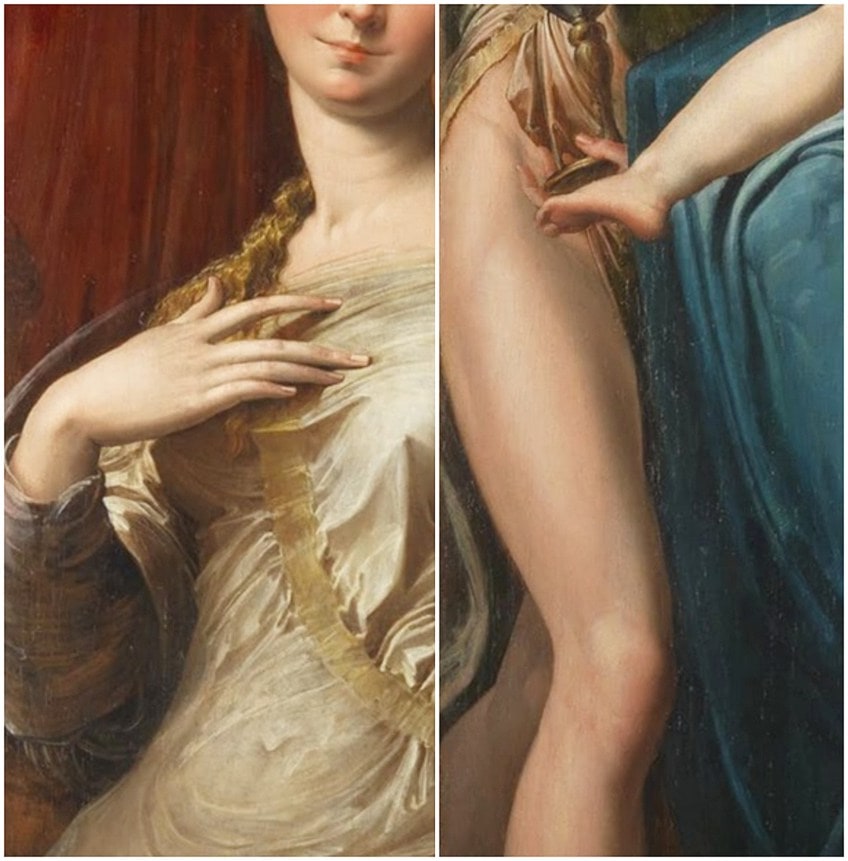
More About Mannerism
For a better understanding of the Madonna With the Long Neck painting, it is useful to know more about the Mannerism art movement, which informed so much about how Parmigianino painted his version of the Madonna. We have already mentioned the inherent religious and sensual meanings, but the Madonna With the Long Neck painting also follows the elongated forms commonly found in Mannerist paintings.
So, why were forms so elongated?
Mannerism started around the 1520s in Italy and developed differently compared to the styles of the High Renaissance, which sought to convey Classical ideals, which would follow symmetrical proportions and have a “naturalism”. Mannerism has been described as “anti-Classical” and often depicts forms and subject matter that was “unnatural” or “artificial”.
It was a reaction to the idealization and somewhat perfected forms that artists portrayed from the High Renaissance, of which artists like Leonardo da Vince and Michelangelo dominated. With this, the elongation of forms became a stylistic trait. Interestingly, the word Mannerism originates from the word maniera, which is an Italian word meaning “style” or “manner”.
Formal Analysis: A Brief Compositional Overview
Below is a formal analysis of Madonna With the Long Neck by Parmigianino, which will discuss the artist’s stylistic approach according to the art elements of color, texture, line, shape, form, and space, including mention of how art principles are also utilized.
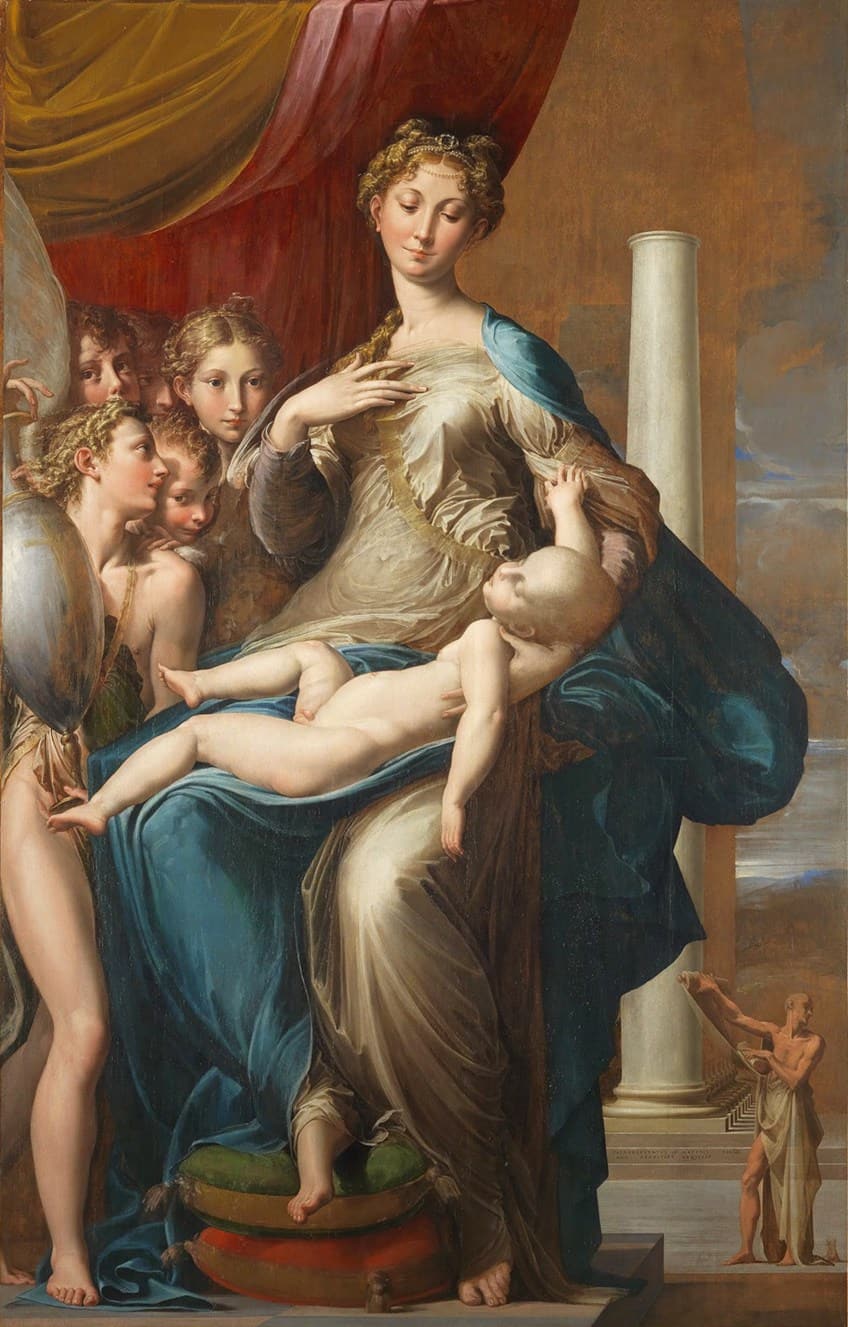
Subject Matter: Visual Description
The Madonna With the Long Neck painting depicts a scene with the Virgin Mary partially cradling the infant figure of Jesus Christ on her lap surrounded by angels and Saint Jerome in an unknown space with several marble columns.
If we look closer, to the left of the composition are six angels huddled cheek-to-cheek next to the central figure of the Virgin Mary.
The angel to the left is holding a large vase and looking affectionately at the Virgin Mary. He is semi-clothed, and his right leg is fully exposed, his right foot is planted on the Virgin Mary’s long blue robe trailing to the floor. The other angels behind him are barely visible except for the heads next to one another, seemingly eagerly trying to get a view of the infant Jesus Christ.

An interesting fact about the angels is that while at first glance there appears to be five, there is actually another (sixth) angel positioned under the Virgin Mary’s right elbow. This hidden angel is looking in the other direction towards the angel holding the large vase.
Reportedly, this was one of the unfinished figures.
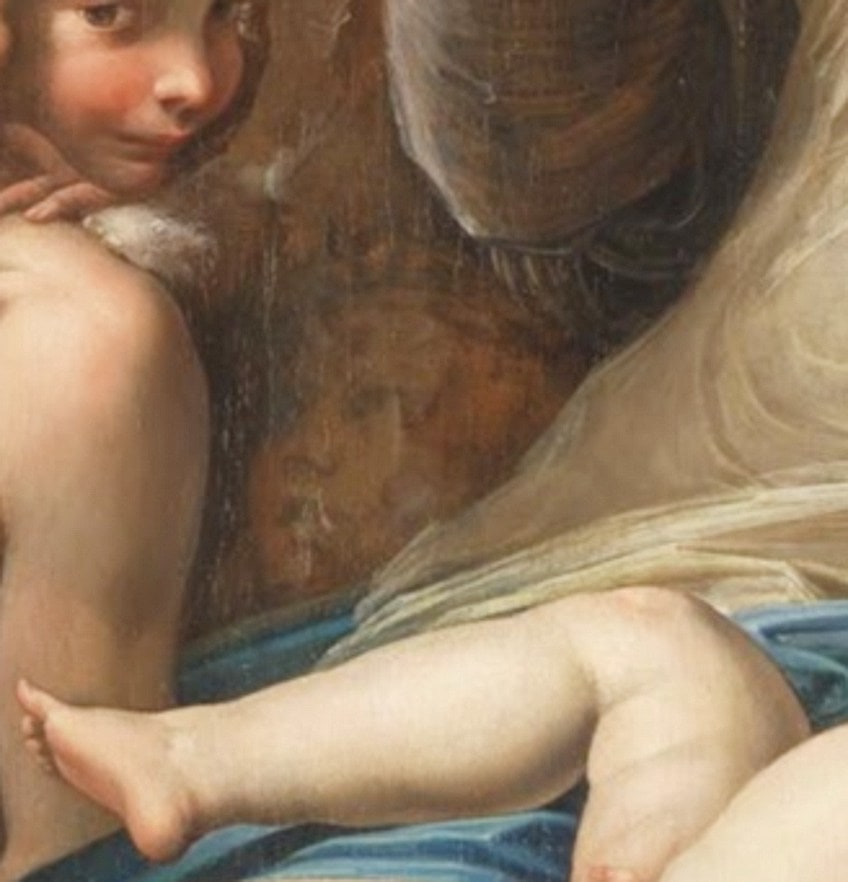
The Virgin Mary is seated and appears taller in stature compared to the angels to the left; she is resting her right foot on two pillows on the floor in front of her while her left foot’s toes are touching the floor as she balances.
Her right hand is slightly touching her upper chest as she lovingly stares down at the infant of Jesus Christ on her lap, who appears oversized, and has been described as unnaturally large for an infant figure.
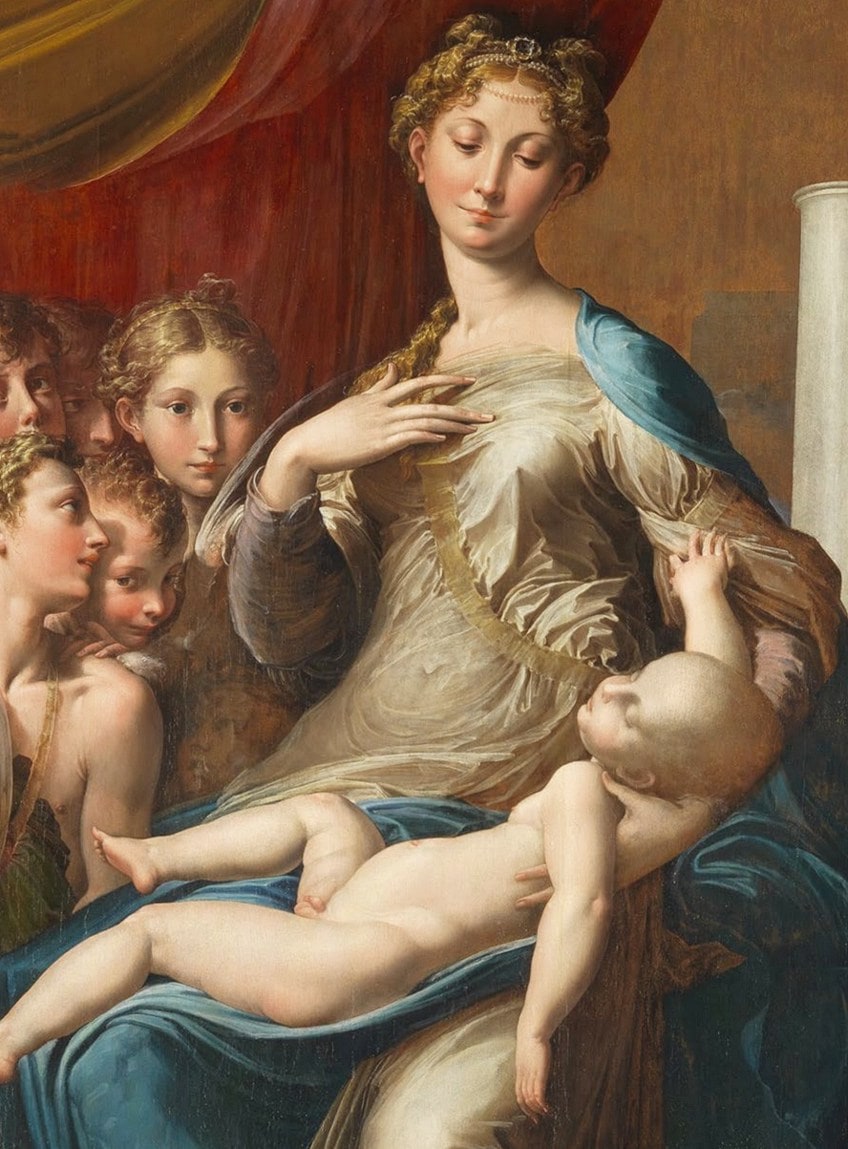
Furthermore, he appears almost lifeless on the Virgin Mary’s lap and his legs dangle off her upper right leg. His eyes are closed and His head is slightly tilted back, supported by the Virgin Mary’s left hand, which is placed around the back of his left underarm. His right arm is extended outwards and his right hand barely touches the Virgin Mary’s clothing on her upper left arm.
Some have described him as being dead, but others that he is asleep.

To the right of the composition is a small figure of Saint Jerome, who is wearing a robe, but his shoulders and chest are exposed, as well as his right leg to his upper thigh area. He is holding an opened scroll and his head is turned to his left (our right).
A fact about Saint Jerome is that he symbolizes a close connection to what is referred to as the “adoration of the Virgin Mary”, and he also translated the Holy Bible into Latin.
It appears as if he is looking at someone next to him, and interestingly, he was reportedly looking at Saint Francis, who is identifiable only by a foot painted by Parmigianino. This was because the painting was still incomplete.
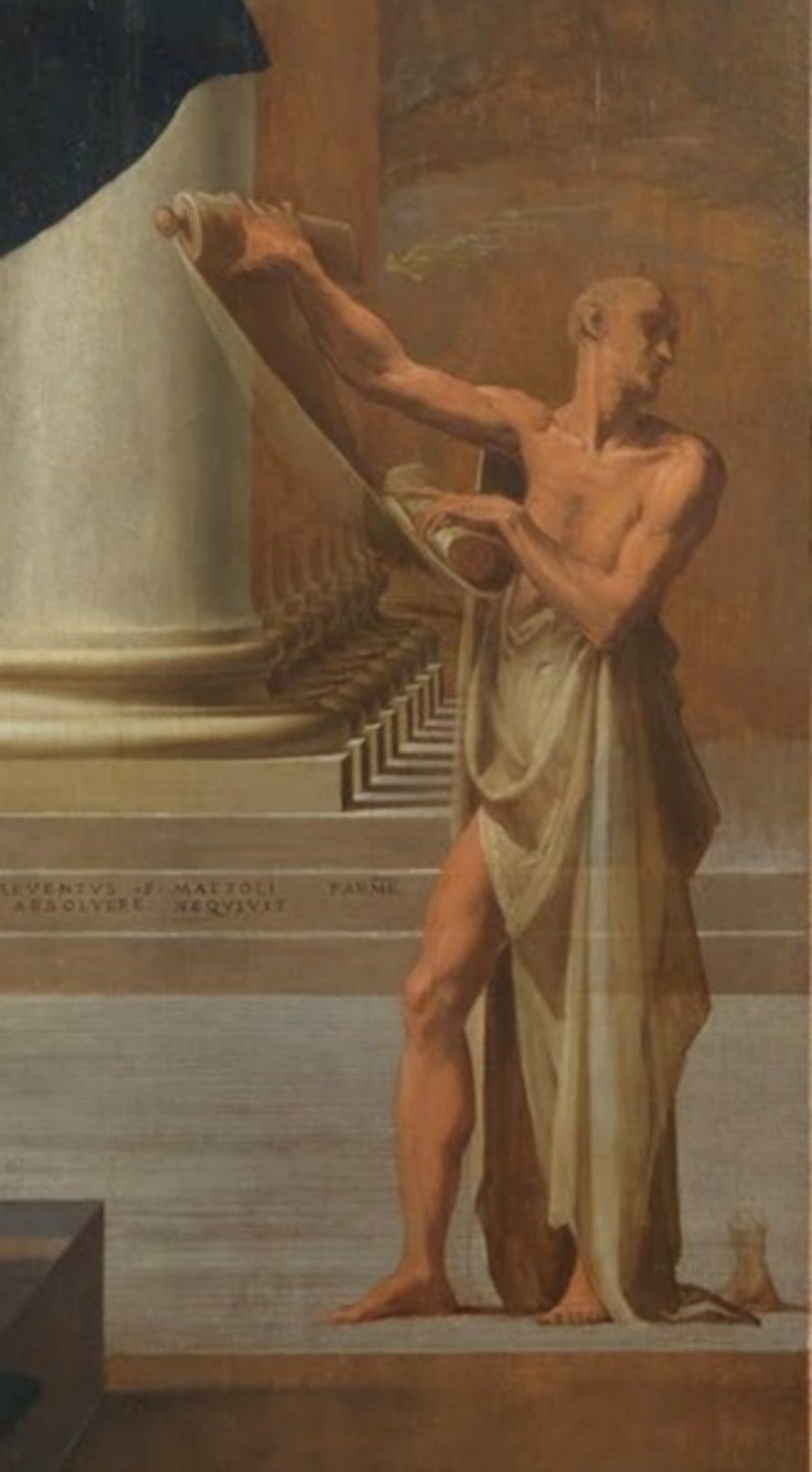
To the left of the background is what appears to be a large curtain or hanging drapery, which creates a backdrop effect, and to the right is a row of several columns with what appears to be a natural landscape in the distance. It is uncertain where the figures are sitting.
Furthermore, on the steps leading up to the columns is an inscription that reads: “FATO PRAEVENTUS F. MAZZOLI PARMENSIS ABSOLVERE NEQUIVIT”, which translates to “Adverse destiny prevented Francesco Mazzola from Parma from completing this work”.

Color
The color scheme is muted in Madonna With the Long Neck, with the subtle hue of blue for the Virgin Mary’s robe and the soft red and almost mustard yellow or gold for the drapery in the background. There are also more neutral colors like whites and beiges found throughout the painting.
Furthermore, the use of color in the smooth skin tones of the figures in the foreground provide them with an air of youth and vibrancy.
Texture
The texture of the paint is smoothly applied with various implied textures. An example includes the folds of the robe worn by the Virgin Mary, which creates the appearance of softness and delicacy. There are also the textures of the smooth and hard surfaces of the columns in the background as well as that of the finer brushstrokes used to create the soft curls of the figures’ hair.

Line
Vertical lines are dominant in Madonna With the Long Neck by Parmigianino, which is implied by the columns in the background as well as in the elongated form of the Virgin Mary herself, notably her long neck.
There are no visible outlines that compose the forms.
Shape and Form
There are natural (organic) shapes and forms in the Madonna With the Long Neck painting, and although the artist painted in a naturalistic manner, the forms do not follow the rules of nature, or otherwise, human anatomy.
This is evident in the Virgin Mary’s long neck, as mentioned previously, as well as the sizes of the figures, which do not correlate with how they would appear in real life, such as Saint Jerome compared to the other figures. Furthermore, there is a fluidity in the figures’ forms, which are in the characteristically Mannerist figura serpentinata position, which means “serpentine figure”.
The figure appears in what is termed an “S” shape, which makes the figures appear livelier.
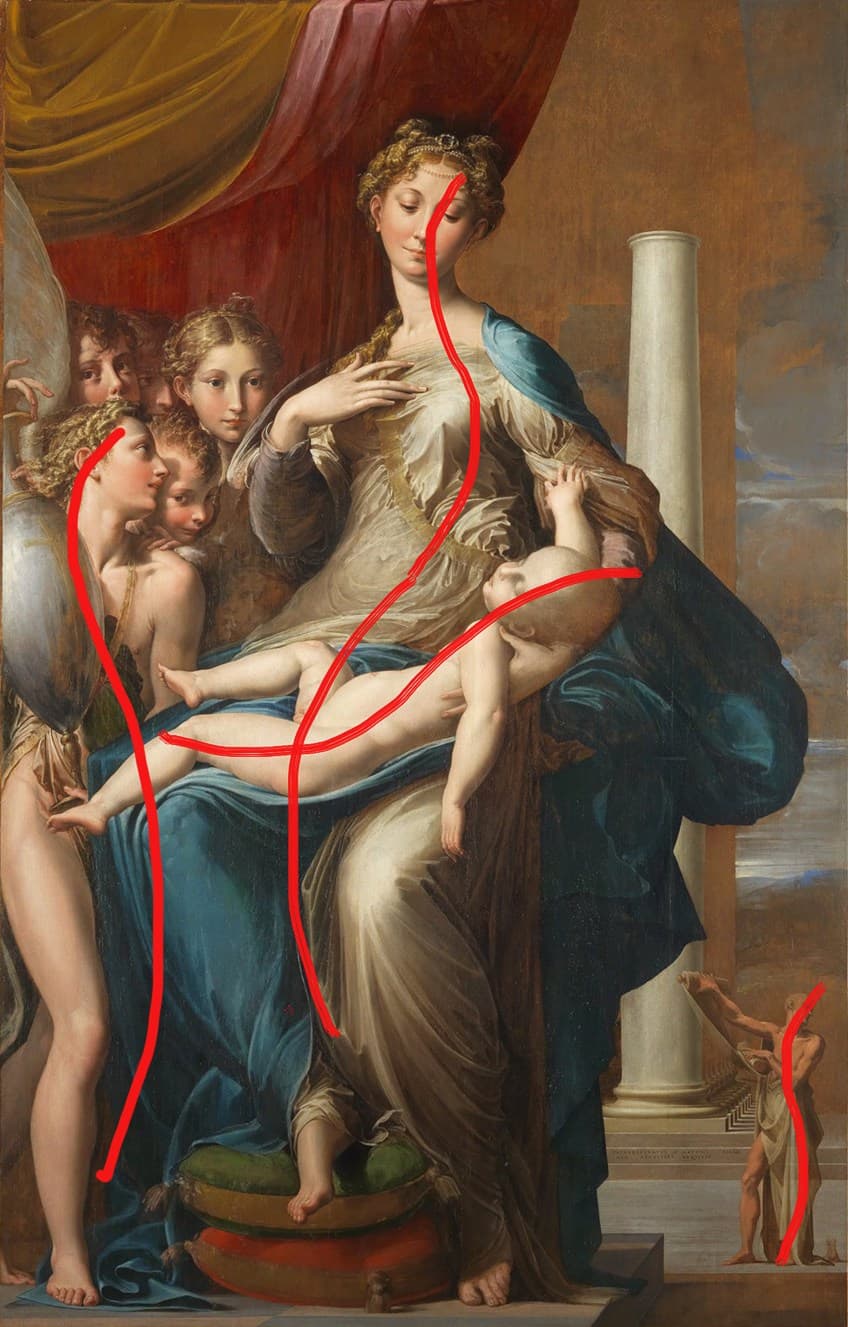
Space
Space in Madonna With the Long Neck painting is utilized in a unique and different manner, for example, the difference in sizes of the figures; the Virgin Mary is depicted considerably larger than the angels, and Saint Jerome, who is dwarfed in size. The figures are also disproportionate.
There is an asymmetrical balance throughout the composition; for example, the left side, which is filled with angelic figures, and the right side, which is more open and leads to the landscape in the distance.
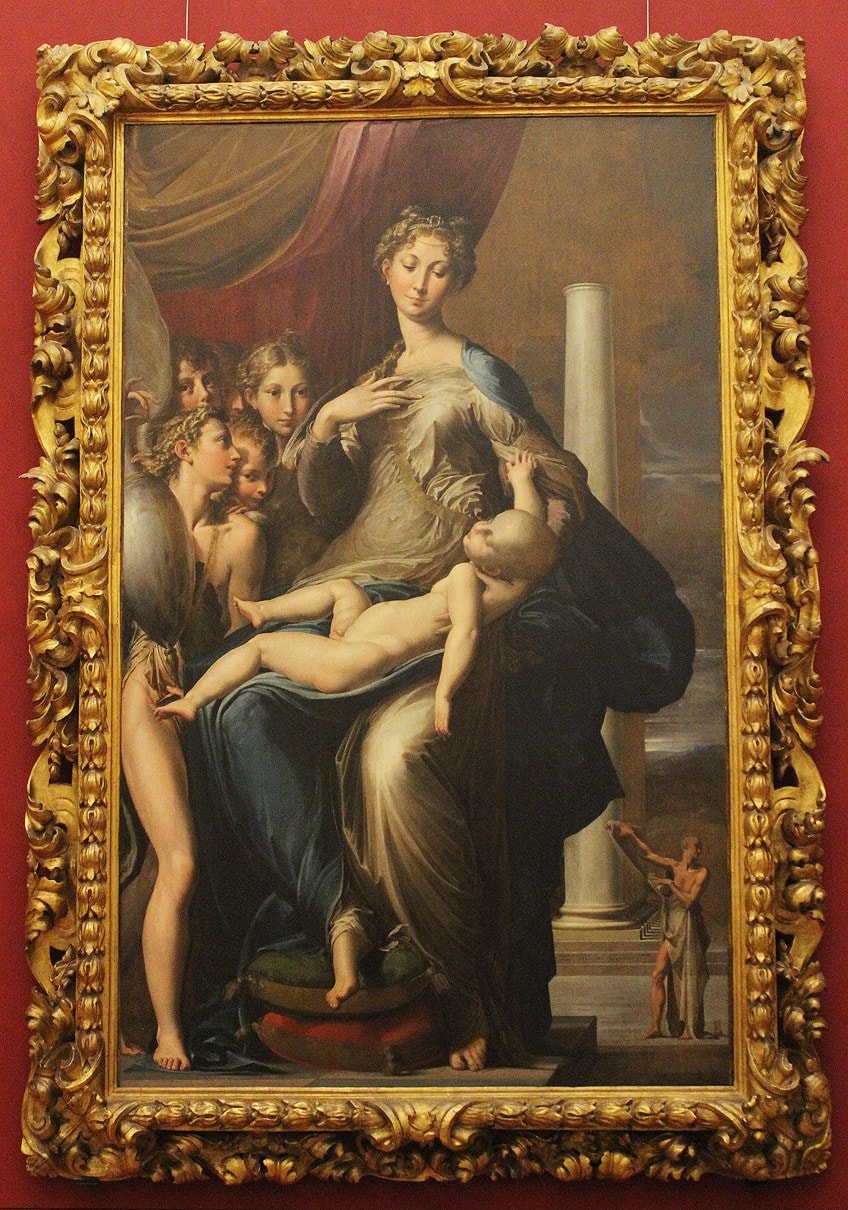
Finding Beauty in Non-Conformity
In this article, we explored Parmigianino’s Madonna With the Long Neck painting, why it was painted, as well as how it has been a lustrous example of Mannerist art, depicting beauty through non-conformity, through a different approach to what was deemed correct from the Renaissance era.
Parmigianino upended what religious subject matter, or devotional art, was expected to be. Although his work has also been likened to the style of Raphael’s, he nonetheless paved his own way that has been described as “unorthodox” and undoubtedly influenced many others to come to see subjects through a different lens altogether.
Frequently Asked Questions
Who Painted Madonna With the Long Neck?
The Italian artist Francesco Mazzola, also known as Parmigianino, painted Madonna With the Long Neck (1534-1540), which is also referred to as Madonna and Child With Angels. It was commissioned by Elena Baiardi Tagliaferri for a chapel in the Santa Maria dei Servi in Parma.
What Art Style Is Madonna With the Long Neck?
The Italian artist Parmigianino, whose full name was Girolamo Francesco Maria Mazzola, painted the oil on panel Madonna With the Long Neck (1534-1540) in the Mannerist art style, which was a style that transitioned from the High Renaissance in Italy. It was also prominent in the North.
Why Does Parmigianino’s Madonna Have a Long Neck?
The Madonna With the Long Neck (1534-1540) by Parmigianino was painted in the Mannerist art style, which was known for its elongated and stylized figures. There was also an element of sensuality and decorativeness to compositions, and the subject matter also varied. It has been described as so-called anti-Classical.
Alicia du Plessis is a multidisciplinary writer. She completed her Bachelor of Arts degree, majoring in Art History and Classical Civilization, as well as two Honors, namely, in Art History and Education and Development, at the University of KwaZulu-Natal, South Africa. For her main Honors project in Art History, she explored perceptions of the San Bushmen’s identity and the concept of the “Other”. She has also looked at the use of photography in art and how it has been used to portray people’s lives.
Alicia’s other areas of interest in Art History include the process of writing about Art History and how to analyze paintings. Some of her favorite art movements include Impressionism and German Expressionism. She is yet to complete her Masters in Art History (she would like to do this abroad in Europe) having given it some time to first develop more professional experience with the interest to one day lecture it too.
Alicia has been working for artincontext.com since 2021 as an author and art history expert. She has specialized in painting analysis and is covering most of our painting analysis.
Learn more about Alicia du Plessis and the Art in Context Team.
Cite this Article
Alicia, du Plessis, ““Madonna With the Long Neck” – Francesco Mazzola’s Masterpiece.” Art in Context. November 16, 2022. URL: https://artincontext.org/madonna-with-the-long-neck/
du Plessis, A. (2022, 16 November). “Madonna With the Long Neck” – Francesco Mazzola’s Masterpiece. Art in Context. https://artincontext.org/madonna-with-the-long-neck/
du Plessis, Alicia. ““Madonna With the Long Neck” – Francesco Mazzola’s Masterpiece.” Art in Context, November 16, 2022. https://artincontext.org/madonna-with-the-long-neck/.


